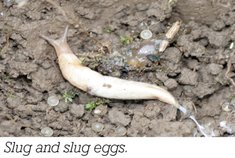Slugs
Slugs are present throughout NZ and can rapidly cause severe seedling loss in establishing pasture and crops. Take particular care with spray-drill or direct-drilling where surface trash is present.
Identification
There are eleven introduced species of slugs in NZ of which the grey field slug is the most common. They generally live in the top 2-3 cm of the soil surface.
Slugs are present in most pastures throughout the year, causing some, but not significant damage. Populations are highest under favourable weather conditions: moist soil, moderate temperature and high humidity.

When undertaking pasture or crop renewal, slugs can be a severe problem, feeding on germinating seed and newly emerged seedlings. Spray-drilled pastures and forage crops are particularly vulnerable.
Slugs can move along the drill rows, killing seedling plants, and utilising the cover of surface trash. Slime trails are often visible with the early morning dew.
Check numbers by leaving wet sacks or similar objects in the paddock overnight just before drilling. Count slugs the next day. Any more than six per object are
considered potentially damaging to pasture establishment

Prevention and management
When sowing into a known slug population, molluscicide baits either at sowing or just prior, can provide economic control (refer to table). Be mindful of the surrounding areas as slugs can move in from roadsides and adjacent paddocks.
Biological control
Mob stocking can give high levels of slug control and can be used before, or immediately after sowing. To be effective aim for 1500 ewes/ha for one night, or 500/ ha for three nights.


